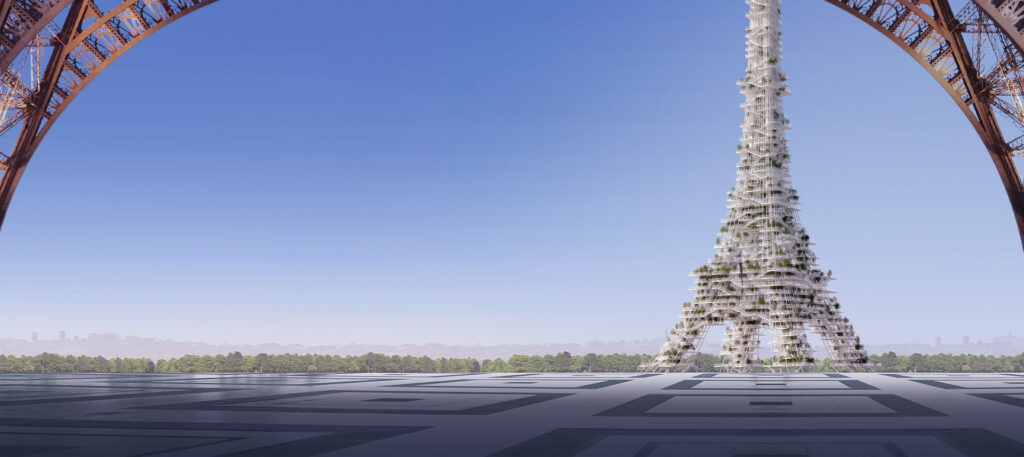What if I told you the key to a more sustainable future might just be an iconic metal structure that’s nearly 140 years-old?
Construction on the Eiffel Tower began in early 1887, after a team led by Gustave Eiffel won a challenge based on his promise to build, in less than two years, a 300-meter tower in Paris. Today, the audacious height, singular shape and distinctive architecture of the tower make it one of the world’s most recognizable landmarks, a symbol of scientific and industrial progress of the time.
The tower is magnificent. A tremendous achievement and breakthrough innovation. But if the challenge was held today, you can bet the tower would be a lot different.
Would puddle iron still make up most of the structure? Where would the materials come from? How would it be transported? What would be the value of this new building for its ecosystem? How would it operate? How would it be built and recycled? And most importantly: what would be its impact on the planet?
Our world today is a very different place than it was when Gustave Eiffel designed his tower.
In the late 1880s, the world’s population still hadn’t hit 2 billion. Last month, the global population reached 8 billion, with expectations to hit 9 billion within another 15 years or so.
Back when the Eiffel tower was designed and built, scientists had only begun to understand the greenhouse effect and the ways in which human activity affects the warming of our planet. Now we’re acutely aware of the dangers of climate change and are working to restrict global warming to 1.5C to stave off incredible and irreversible consequences.

We’re building tomorrow today
Inspired by Gustave Eiffel’s famous tower and by our dedication to harmonize products, nature and life, Dassault Systèmes has gathered a global team of experts to demonstrate the ways environmental challenges can be efficiently addressed by the Infrastructure & Cities sector.
In addition to Eiffel’s original variables like time and scale, we’ve introduced modern concerns around sustainability, like growing populations, rising temperatures and depleted resources. With that in mind, the challenge is to reimagine the Eiffel Tower with the latest digital solutions and technical capabilities to mitigate their impact at each step of the process.
Reimagine a building of yesterday – using the technology of today – for a more sustainable tomorrow
With the “Building Tomorrow” marketing program, we gave our multi-disciplinary team of experts a bold mission: How would they make such a disruptive project sustainable at each critical stage of the value chain?
We asked them to explore and demonstrate how public authorities, engineers, architects, logistics experts and builders can transform the way they work and collaborate at all steps, enabling more circular, efficient and collaborative practices across the infrastructure and cities sector.
Building Tomorrow is of course a virtual project, but designed to inspire all the stakeholders to start now deploying sustainable innovation to harmonize product, nature and life thanks to the power of virtual twins on the 3DEXPERIENCE platform.
The documentary’s episodes highlight five challenges of the sector value chain:
- How can public authorities leverage the virtual twin of the city to implement sustainable urban design?
- How can materials impact be mitigated thanks to the decarbonization of their manufacturing process?
- How can logistics experts enter the process earlier and get more options for sustainable logistics planning software and implementation?
- How can energy and resources needs for the building operations can be anticipated, simulated and optimized thanks to circular systems defined on the virtual twin? For example: the recovery of water to manage the irrigation needs intrinsic to a garden.
- How can we shake the construction processes thanks to “productization” principles to accelerate the design and delivery of unique, sustainable buildings?
Sustainable infrastructure for a sustainable future
The Building Tomorrow project comes at a time when we are at a critical tipping point. As populations rise, people are pushed to cities in search of food, shelter, security and other essentials. This urbanization can strain resources and contribute to unsustainable patterns of production and consumption. However, public authorities, architects, engineers and others can act now to deploy sustainable innovations and adopt more circular practices in infrastructure and cities design, planning and urban development.
This is the decade to deliver for climate change. We only have until 2030 to significantly reduce our way of innovating, creating, building and lifecycling of our assets or we will not have a livable planet to give to our children. Infrastructure and cities must be a part of the solution.
We’re inspired by Gustave Eiffel’s innovation, audacity and willingness to fight for a project that wasn’t widely accepted at the time. We hope the Building Tomorrow program will inspire others to rise to the challenge of our day.
So what would a low-carbon Eiffel Tower look like if it was designed today? I won’t spoil that for you. Head over to our Building Tomorrow page to see for yourself!

